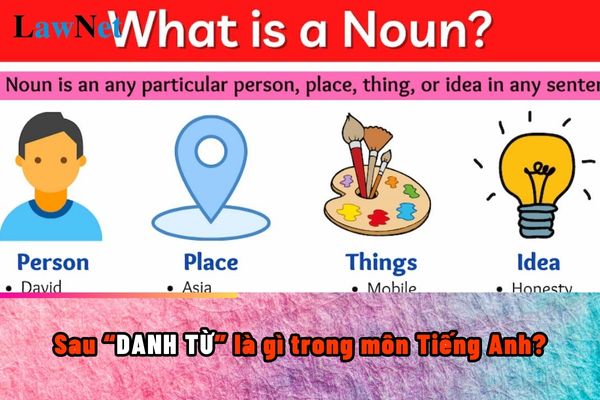What follows a noun in English? When do students in Vietnam learn nouns according to English curriculum?
What follows a noun in English?
Students can refer to the information below for what comes after a noun in English:
|
In English, after a noun, there can be many different types of words, depending on the context and usage. Below are some common cases where a word follows a noun: |
*Note: The information about what comes after a noun in English is for reference only./.

What follows a noun in English? When do students in Vietnam learn nouns according to English curriculum? (Image from the Internet)
When do students in Vietnam learn nouns according to English curriculum?
Based on Section V of the English subject general education program issued together with Circular 32/2018/TT-BGDDT, the required content for primary and lower secondary school levels in the English subject includes:
1.3. Language Knowledge
Language knowledge in the general education program for English encompasses phonetics, vocabulary, and grammar. This knowledge serves as a tool helping students to form and develop communicative competence through four skills: listening, speaking, reading, and writing. The system of language knowledge taught in the program includes:
1.3.1. Primary Level
Phonetics: Phonetics teaching content at the primary level is expressed in two areas: spoken language and written language.
- Spoken language: vowels, consonants, and some consonant clusters; word stress, sentence stress, and basic intonation.
- Written language: the corresponding relationship between sounds and written letters to spell, read, and write correctly the learned words and phrases.
Vocabulary: The vocabulary teaching content at the primary level includes common, simple, and concrete words at Level 1 in English, serving communicative situations within the system of themes and topics of the program. The amount of vocabulary stipulated at the primary level is about 600 - 700 words.
Grammar: The grammar teaching content at the primary level includes structures serving the development of communicative competence at Level 1, such as declarative sentences, questions, commands, affirmative sentences, negative sentences, simple sentences, the present simple tense, the present continuous tense, the past simple tense, the future simple tense, modal verbs, singular nouns, plural nouns, personal pronouns, demonstrative pronouns, interrogative pronouns, possessive adjectives, possessive pronouns, adverbs, cardinal numbers, ordinal numbers, common prepositions, common conjunctions, and articles...
1.3.2. Lower secondary Level
Phonetics: Phonetics teaching content at the lower secondary level includes: single vowels, diphthongs, semi-vowels, consonants, consonant clusters; word stress, sentence stress, rhythm, and basic sentence intonation.
Vocabulary: The vocabulary teaching content at the lower secondary level includes common words expressed in two areas of spoken and written language related to the themes and topics in the program. The amount of vocabulary stipulated at the secondary level is about 800 - 1000 words at Level 2 (not including the words learned in primary school).
Grammar: The grammar teaching content at the lower secondary level continues to consolidate and expand on the content learned at the primary level and includes structures serving the development of communicative competence at Level 2, such as declarative sentences, questions, commands, exclamatory sentences, affirmative sentences, negative sentences, simple sentences, simple compound sentences, conditionals (type 1), relative clauses, the present simple tense, the present continuous tense, the past simple tense, the past continuous tense, the future simple tense, the near future tense, modal verbs, infinitives, gerunds, participles, countable nouns, uncountable nouns, possessive forms of nouns, ordinal numbers, adjective comparisons, demonstrative pronouns, interrogative pronouns, relative pronouns, reflexive pronouns, possessive pronouns, prepositions, adverbs, conjunctions, definite articles, indefinite articles...
Thus, according to the above regulations, students will learn about what nouns are in English in the program at both primary and secondary levels, that is, in primary and lower secondary school.
What are regulations on assessing educational outcomes of English subject in primary level in Vietnam?
Based on Section VII of the English subject general education program issued together with Circular 32/2018/TT-BGDDT, the regulations on assessing educational outcomes of English subject in primary level in Vietnam include:
- Testing and assessment are crucial elements in the teaching process to provide feedback on the students' communicative competence in English acquired during and upon completing a learning phase.
- This contributes to encouraging and guiding students in their learning process and helps teachers and schools evaluate students' learning outcomes, thereby adjusting the teaching of the subject effectively at different educational levels.
- The assessment of student activities must closely follow the objectives and content of the program, based on the required proficiency for communication skills at each grade level, aiming to help students achieve the predefined communicative competence levels upon completing primary, secondary, and high school levels.
- Assessment activities should be conducted in two forms: continuous assessment and periodic assessment. Continuous assessment is carried out consistently through class activities.
- During the teaching process, priority should be given to continuous assessment to help students and teachers track the progress of achieving the objectives outlined in the program. Periodic assessment is conducted at specified times during the school year to evaluate achievement relative to the set requirements for each grade level.
- The final assessment at the end of primary, secondary, and high school levels must be based on the required foreign language proficiency level according to the 6-level foreign language proficiency framework for Vietnam, specifically Level 1 for primary school, Level 2 for lower secondary school, and Level 3 for high school.
- The assessment is conducted through various forms, such as quantitative, qualitative, and a combination of both quantitative and qualitative throughout the learning process, combining teacher assessment, peer assessment, and self-assessment by students.
- The types of tests and assessments should be consistent with the teaching methods applied in the classroom, including oral (dialogue, monologue) and written tests in the form of integrated skills and language knowledge, combining multiple-choice questions, short answers, and other assessment forms.
>>> Download the general education program for English.

